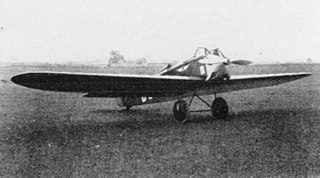
The Focke-Wulf Fw 44 Stieglitz (Goldfinch) is a 1930s German two-seat biplane. Designed by Kurt Tank in 1931, it was the Focke-Wulf company's first major international success. Produced as a pilot training and sports flying aircraft. It was also built under license in several other countries.

The Messerschmitt Bf 108 Taifun was a German single-engine sport and touring aircraft, developed by Bayerische Flugzeugwerke in the 1930s. The Bf 108 was of all-metal construction.

The Udet U 12 Flamingo was an aerobatic sports plane and trainer aircraft developed in Germany in the mid-1920s.

The Thomas-Morse O-19 was an American observation biplane built by the Thomas-Morse Aircraft Company for the United States Army Air Corps.

The BFW M.20 was a German single-engine, high-wing monoplane ten-seat passenger transport aircraft, developed in the late 1920s and early 1930s. Deutsche Luft Hansa used it throughout the 1930s on a variety of routes.

The Fokker S.IV was a military trainer aircraft produced in the Netherlands in the mid-1920s. It was a conventional, single-bay biplane with staggered wings of unequal span braced with N-struts, essentially a radial-engined development of the S.III. The pilot and instructor sat in tandem, open cockpits and the undercarriage was of fixed, tailskid type with a cross-axle between the main units. The Royal Netherlands Army Aviation Group purchased 30 examples and used them right up to the German invasion of the Netherlands in 1940. On 14 May that year, a few surviving S.IVs escaped to France alongside some S.IX trainers, but never flew again.

The ICAR 36 / ICAR Comercial (sic), variously also known as the ICAR M 36, Messerschmitt M 36 or BFW M.36, was a Messerschmitt design built and tested by the Romanian company ICAR in the mid-1930s. It was a small, single-engine high-wing airliner, the first civil transport aircraft built in Romania.

The ICAR Universal was a 1930s Romanian two seat monoplane trainer, touring and aerobatics aircraft.

The Bayerische Flugzeugwerke M 18, was an airliner, produced in Germany in the late 1920s.

The BFW M.23, sometimes known as the Messerschmitt M 23, was a 1920s two-seat sporting aircraft designed by Willy Messerschmitt, and produced by Bayerische Flugzeugwerke (BFW). Examples won several prestigious races in 1929 and 1930.

The BFW M.35, sometimes known as the Messerschmitt M 35, was a German sports plane of the early 1930s. It was the last of a line designed by Willy Messerschmitt.

The BFW M.27, sometimes known as the Messerschmitt M.27, was a German two-seat sports plane with a low, cantilever wing, open cockpits and a fixed undercarriage sold in small numbers at the start of the 1930s.

The BFW M.31, sometimes known as the Messerschmitt M.27, was a radial-engined German two-seat sports plane from 1932, with a low, cantilever wing, open cockpits and fixed undercarriage. Only one was built.
The BFW M.19, sometimes known as the Messerschmitt M 19, was the first in a line of German low-wing single-engine sports planes, designed by Willy Messerschmitt while he worked for Bayerische Flugzeugwerke (BFW).
The BFW M.29 was a single-engine two-seat low-wing aircraft, designed by Willy Messerschmitt for the 1932 Circuit of Europe races.

The Henschel Hs 122 was a German army cooperation/reconnaissance aircraft of the mid-1930s, radial-engined and with a parasol wing. Though only pre-production variants entered service, the Hs 122 led on to the Hs 126 which was produced in large numbers.
The BFW M.22 was a twin-engined medium bomber, designed by Willy Messerschmitt for the German Ministry of Transport. It was one of only two biplanes Messerschmitt designed, both unsuccessful.
The BFW M.26 was a single-engined cantilever-winged monoplane light airliner built in Germany in 1930. There were no sales and only one was built.

The Dietrich DP.II Bussard was a 1920s German two-seat training biplane designed by Richard Dietrich and built by the Dietrich-Gobiet Flugzeugwerke as Kassel.

The Udet U 1 was the first of a line of small, low-powered, low wing, cantilever monoplanes built in Germany in the early 1920s.
















